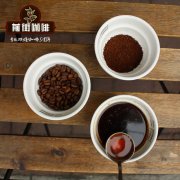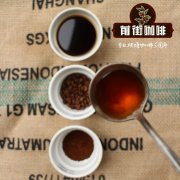Classification of treatment methods? Insolation, half-sun, water washing, half-washing, what is the difference in honey treatment? Mouth

Professional coffee knowledge exchange More coffee bean information Please pay attention to coffee workshop (Weixin Official Accounts cafe_style)
Treatment classification? What is the difference between sun, semi-sun, water, semi-water and honey treatment? Difference in taste and flavor characteristics?
After planting and harvesting, the next step is the most important step besides variety and planting area: 'post-processing method'. At present, most of the treatment methods are sun, semi-washing, water-based, and there are several special treatment methods: honey treatment, in vivo treatment method, etc.; there are also many people sharing these treatments on the network, how do I write them is similar, but their preferences for treatment methods are also different, in addition to the treatment method according to their own humble ideas to write down, will add some of their own ideas in it, if these ideas are biased, please give me some advice.
However, the first thing that will be experienced before processing is to select the mature fruit; there are two methods: first, the use of color distinction: usually mature fruit will be red skin for ripening characteristics, at this time most of the sugar in the pectin layer has penetrated into the fruit, will greatly increase the sweetness, fruity; relatively if the immature fruit, will contain a lot of chlorogenic acid and high concentration of citric acid, so that coffee fruit add sour taste.
Second, all the picked fruits will be thrown into the tank: ripe and about to mature fruit will sink to the bottom, while immature fruit and bad fruit will float, but sometimes it will be found that a large number of ripe fruits are pressed under the tank.
Solarization:
It is usually used in countries where water is scarce, but in recent years it has often been used by some estates that pursue special flavors because of its unique flavor. After selecting the ripe fruit, spread it in the bean drying field for natural drying, turn the coffee beans at any time to avoid part of the moisture caused by mold, and the time depends on the climate, about two to four weeks after the fruit moisture content dropped to 12% below and hardened, and then use the shell machine to dry the hard pulp and sheepskin layer, take out the coffee beans. This treatment method is most afraid of rain moisture caused by mildew, every night also because of avoiding excessive moisture, need to move it indoors.
I like the flavor of this kind of treatment very much. Although I have drunk the horrible flavor of over-fermented, it is really fascinating in the case of moderate fermentation. The sun-specific berry and wine tone can make it have a very beautiful flavor no matter what cooking method is used; however, there is a miscellaneous flavor that is easy to be expressed, which tests the ability of the baker and the bartender.
Half-sun method: divided into Brazilian half-sun, mechanical half-sun
Brazil half sun: After picking out the ripe fruit, sift out the pods containing pectin; without fermentation, move to the outdoor bean drying field, because the climate in Brazil is dry, the pectin will harden in about one day, during which time the pods need to be turned to avoid moisture odor, about two to three days, the pods can reach a certain degree of dehydration, in the use of a dryer to further dry, so that the water content is reduced to 10.5%-12%, in the storage of beans for several days to further mature, before export, the sheepskin layer will be ground, coffee beans classification.
Mechanical semi-solarization: use in areas where water is scarce and moisture is heavy. After picking out the ripe fruit, sift out the pods containing pectin, pour them directly into the pectin scraper, take out the pods with smooth surface, and then take them to the outdoor sun until the moisture content drops to 12%.
In order to suit the degree of sun, I also like the taste of this kind of treatment method, with a little sun flavor, so that berry aroma and coffee bean sweetness with more layers; but if the treatment is not good, too much sun to reduce the moisture or insufficient sun time to make the moisture too high, sweetness and sun flavor will make the overall ratio of extremely high changes.
Washing method: general washing method, Kenyan washing method, Rwandan washing method
Washing method can make coffee beans beautiful in color, good in appearance and high in quality; acid flavor and brightness are better, and there is no miscellaneous taste; but the water cost is extremely high, so it is not suitable in some countries with poor water resources.
General washing method: after selecting ripe fruit, move it to pulp screening machine, followed by the most important washing fermentation treatment to remove pectin layer; causal layer is not easy to remove with water, so various bacteria in water hydrolysis, will be decomposed into pectic acid, during the need to constantly stir and wash the coffee beans in the tank with water, accelerate pectin separation from pods. About 12--36 hours, depending on the temperature and humidity, at this time the tank will naturally produce malic acid, citric acid, acetic acid, propionic acid, part of the acid fragrance spirit will also penetrate into the coffee beans; check the fermentation status in the tank at any time, check whether the pectin layer has fallen off, in order to avoid excessive fermentation to produce excessive fatty acids and butyric acid and emit odor; after the completion of water washing fermentation, coffee beans will be taken out, dried and stored.
Kenyan washing: After the same process as the general washing method, the natural fermentation for 12 hours (mainly pH 4.5--4.8), then wash 80%--90% of the pectin layer, in the natural fermentation for 24 hours, clean, and then soaked in water for 24 hours, dry and then put into the warehouse.
Rwandan washing: after the initial process of the same general washing method, the natural fermentation is carried out for 12 hours, after cleaning, the fermentation is carried out in water for 24 hours, and then the washing is carried out again. After soaking in water for 20 hours, the drying is carried out and then the storage is carried out.
This washing method gives the coffee beans a clean and bright acidity, high moisture content, bright sour aroma in the case of coffee, high sweetness, clean taste. The author feels the most about this kind of treatment method, it is easy to have more easily distinguished layering, it is easier to find the unique taste of coffee, and the special flavor of the origin.
Honey treatment:
The so-called honey treatment is to remove the coffee cherry peel, leaving the sticky pulp part, and then drying treatment, and then remove the pulp layer and pectin layer, and then into the warehouse. During the drying period, high frequency of continuous stirring is required to avoid mildew caused by adhesion between the pulp; and drying in a short time is required to avoid excessive fermentation; the above various reasons will cause the risk of easy deterioration of the honey treatment method, so it will require more labor and time costs than other treatment methods. The percentage of pulp retained was divided into several honey treatments: 80% pulp 'black honey'; 60% pulp' red honey'; 40% pulp 'yellow honey'; 20% pulp' white honey'; all with different flavors and presentations.
The author does not dabble in coffee of this kind of treatment, but for the same coffee bean, there is generally a higher body, a longer ending rhyme, and a good performance in the sweetness display, and even the sweetness can be pulled to the ending rhyme part; but unfortunately, it is more difficult to drink clean honey treated coffee beans, and the miscellaneous flavor often floats out suddenly and then disappears, but overall it does not affect the taste display.
Important Notice :
前街咖啡 FrontStreet Coffee has moved to new addredd:
FrontStreet Coffee Address: 315,Donghua East Road,GuangZhou
Tel:020 38364473
- Prev

Coffee fruit solarization, honey treatment, water washing, semi-washing, barrel fermentation, paste impregnation fermentation
Professional coffee knowledge exchange more coffee bean information Please follow the coffee workshop (Wechat official account cafe_style) Coffee fruit sun drying, honey treatment, water washing, semi-washing, barrel fermentation, paste impregnation fermentation treatment what is the difference? When coffee still grows on the tree with peel and pulp, it is called coffee cherry. Coffee beans are only used in the middle of the seed and picked.
- Next

Coffee fruit treatment method solarization method, washing method or half sun method which is better? What's the difference? Yes
Professional coffee knowledge exchange more information about coffee beans Please follow the coffee workshop (Wechat official account cafe_style) Coffee fruit treatment method which is better, washing or half-sun? What's the difference? What are the flavor and taste characteristics? The oldest treatment of solarization (Natural) is widely used in sunny, water-poor and less affluent areas.
Related
- Detailed explanation of Jadeite planting Land in Panamanian Jadeite Manor introduction to the grading system of Jadeite competitive bidding, Red bid, Green bid and Rose Summer
- Story of Coffee planting in Brenka region of Costa Rica Stonehenge Manor anaerobic heavy honey treatment of flavor mouth
- What's on the barrel of Blue Mountain Coffee beans?
- Can American coffee also pull flowers? How to use hot American style to pull out a good-looking pattern?
- Can you make a cold extract with coffee beans? What is the right proportion for cold-extracted coffee formula?
- Indonesian PWN Gold Mandrine Coffee Origin Features Flavor How to Chong? Mandolin coffee is American.
- A brief introduction to the flavor characteristics of Brazilian yellow bourbon coffee beans
- What is the effect of different water quality on the flavor of cold-extracted coffee? What kind of water is best for brewing coffee?
- Why do you think of Rose Summer whenever you mention Panamanian coffee?
- Introduction to the characteristics of authentic blue mountain coffee bean producing areas? What is the CIB Coffee Authority in Jamaica?

